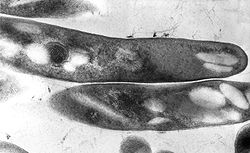| Mycobacteriaceae | |
|---|---|
 | |
| Scientific classification | |
| Domain: | Bacteria |
| Kingdom: | Bacillati |
| Phylum: | Actinomycetota |
| Class: | Actinomycetes |
| Order: | Mycobacteriales |
| Family: | Mycobacteriaceae Chester 1897 (Approved Lists 1980) [1] |
| Genera. [2] | |
| |
Mycobacteriaceae is a family of bacteria in the phylum Actinomycetota. [1] [2] Its name is derived from the Mycobacterium genus, which includes pathogens known to cause serious diseases in mammals, including tuberculosis ( M. tuberculosis ) and leprosy ( M. leprae ) in humans. The Greek prefix myco- means 'fungus', alluding to the mold-like appearance of these organisms on agar plates. [3]